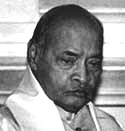

 |  |
 The short-lived Chandra Shekhar government, which took office on 10 November 1990 with the support of Congress, had only one role to perform: to hold the baby till Congress decided it wanted to go for elections. A pretext was found and support withdrawn on 5 March 1991. The elections were announced from 19 May and one round of voting was over when tragedy again struck the ill-fated family of Indira Gandhi. The short-lived Chandra Shekhar government, which took office on 10 November 1990 with the support of Congress, had only one role to perform: to hold the baby till Congress decided it wanted to go for elections. A pretext was found and support withdrawn on 5 March 1991. The elections were announced from 19 May and one round of voting was over when tragedy again struck the ill-fated family of Indira Gandhi. Rajiv Gandhi, who was rounding off one phase of campaigning with a late-night meeting in Sriperumbudur, forty kilometres from Madras, was blown to pieces when a young woman, who came forward to greet him, triggered off a bomb that she had strapped to her waist. Widely believed, and later proven, to be the handiwork of LTTE militants, the killing of the forty-six-year-old Rajiv generated a sympathy wave strong enough to give Congress 232 seats and the status of the single largest party. Narasimha Rao formed what was initially a minority Congress government on 21 June, but which gradually achieved a majority, and lasted a full five-year term. It undertook the most radical economic reform, and in the first year brought down the caste and communal temperature to a great extent and was successful in restoring normalcy to Punjab, and improving the situation in Kashmir and Assam. It failed to save the Babri Masjid from demolition, and prevent the widespread rioting that followed.  Suffice it to say that Narasimha Rao’s regime, despite its many achievements which are likely to be placed in a more favourable light with a longer historical perspective, tended to lose steam in the last two years, with a slowing down of economic reforms, surfacing of corruption charges and the ‘hawala’ scandal which led to charges, later found to be almost entirely unsustainable, of bribes and foreign exchange violations against many Congress and opposition leaders. Suffice it to say that Narasimha Rao’s regime, despite its many achievements which are likely to be placed in a more favourable light with a longer historical perspective, tended to lose steam in the last two years, with a slowing down of economic reforms, surfacing of corruption charges and the ‘hawala’ scandal which led to charges, later found to be almost entirely unsustainable, of bribes and foreign exchange violations against many Congress and opposition leaders.The elections held in 1996 led to Congress winning only 140 seats and BJP increasing its tally to 161 from 120 in 1991. A short-lived BJP government lasted from 16 May to 1 June, but failed to get majority support. A United Front government followed this with H.D. Deva Gowda as prime minister supported by Congress and CPM in which CPI joined as a partner and India got her first Communist home minister in Indrajit Gupta. Congress withdrew support on 30 March 1997, failed to form a government, and again supported a United Front government, this time with I.K. Gujral as prime minister. The support was withdrawn again and fresh elections held in February 1998 that led to the formation of BJP-led government with Atal Behari Vajpayee as prime minister, as BJP, with 182 seats had the support of parties like the TDP, AIADMK and Trinamul Congress. |
Copyright ©2000 indiansaga.info. All rights reserved.
By using this service, you accept that you won't copy or use the data given in this website for any commercial purpose.
The material on indiansaga.info is for informational & educational purpose only.
This site is best viewed at 800 X 600 picture resolution.